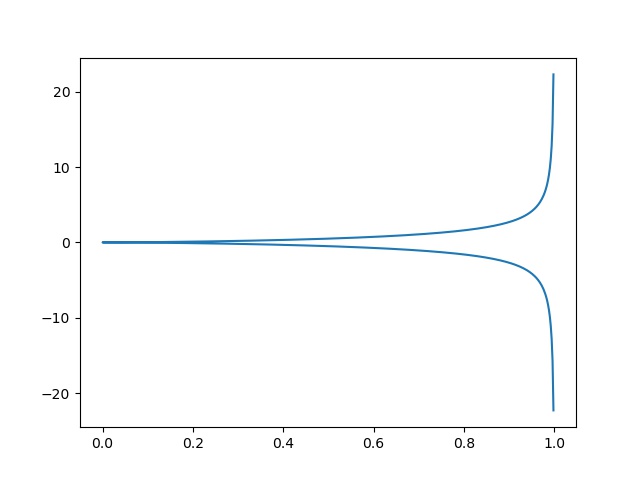Reparameterization and unit-length curve
Reparameterization
A curve can have different parameterizations (even infinite ways).
For parameterized curves \(\gamma: (a, b)\rightarrow\mathbb R^n\) and \(\tilde\gamma: (\tilde a, \tilde b)\rightarrow\mathbb R^n\).
IF \(\exists \phi: (a, b)\rightarrow (\tilde a, \tilde b)\) and its inverse \(\phi^{-1}\) (since bijective) and \(\phi, \phi^{-1}\) are both smooth and
THEN \(\tilde\gamma\) and \(\gamma\) are reparameterizations of each other.
Example \(\gamma(t) = (\cos t, \sin t), \tilde \gamma(s)= (\sin s, \cos s)\) are both reparameterizations of each other, parameterizing the same circle \(x^2 + y^2 = 1\).
Take \(\phi(s) = \pi/2 - s, \phi^{-1}(t) = \pi/2 - t\), \(\gamma(t) = \gamma(\phi(s)) = \tilde\gamma(\phi^{-1}(t))\).
Claim 1
If \(\gamma_1\) is a reparameterization of \(\gamma_0\), \(\gamma_2\) is a reparameterization of \(\gamma_1\), then \(\gamma_2\) is a reparameterization of \(\gamma_0\).
proof. Take map \(s_0\) s.t. \(\gamma_1(s_0(t)) = \gamma_0(t)\), take map \(s_1\) s.t. \(\gamma_2(s_1(t)) = \gamma_1(t)\). Then, let \(s_2 = s_1\circ s_0\) so that \(\gamma_2(s_2(t)) = \gamma_2(s_1(s_0(t))) = \gamma_1(s_0(t)) = \gamma_0(t)\). Note that \(s^{-1}_2 = s_0^{-1}\circ s_1^{-1}\) as a composition of invertible functions, is also invertible; and composition of smooth functions is also smooth.
Example: Cissoid of Diocles
The cissoid of Diocles (see below) is the curve
Claim the curve can be parameterized by
proof. Convert the polar coordinates to Cartesian coordinates
Therefore, let \(t = \sin\theta\), note that this function is bijective on \((-1, 1)\rightarrow (-\frac{\pi}{2},\frac{pi}{2})\) and both \(\sin\theta\) and \(arc\sin\theta\) are smooth on the specified domain.
Example: Ordinary cusp
A point \(\mathbf p\) of \(\gamma\), corresponding to a parameter value \(t\), is an ordinary cusp if the curve is singular at the point and \(\gamma''(t)\) and \(\gamma'''(t)\) are linearly indepedent and non-zero.
Claim If \(\gamma\) has an ordinary cusp at a point \(\mathbf p\), so does any reparam of it.
proof. Let \(\gamma\) be a parameterized curve and with reparameterization \(\tilde\gamma\) and map \(s\) s.t. \(\tilde\gamma(s(t)) = \gamma(t)\). Assume that for some \(t_0\) s.t. \(\gamma'(t_0) = 0\), \(\gamma''(t_0), \gamma'''(t_0)\) are linearly independent and non-zero.
Since \(s\) is smooth, \(ds/dt \neq 0\implies \frac{d\tilde\gamma}{ds} = 0\)
Obviously, the two vectors aren't multiple of each other.

Regular point and regular curves
A point \(\gamma(t)\) is a regular point if \(\gamma'(t)\neq 0\), otherwise \(\gamma(t)\) is a singular point.
A parameterized curve \(\gamma\) is a regular curve if \(\forall t \in (a, b). \gamma'(t)\neq 0\).
Note that for the same level curve, it might be parameterized into both regular curve and non-regular curve.
Example of Regular Curves
Claim the circle with parameterization \(\gamma: \mathbb R\rightarrow \mathbb R^2, \gamma(t) = (\cos^2 t, \sin^2 t)\) is not regular
Claim \(\gamma(t) = (t, \cosh t)\) is regular
Properties of regular curves
Claim Any reparameterization of a regular curve is regular.
proof. Let \(\gamma(t)\) be a regular curve and \(\tilde\gamma(s)\) be reparameterization with \(t = \phi(s) = \phi(\phi^{-1}(t))\). Differentiating the equation will give
Hence \(\frac{d\phi}{ds}\neq 1\). So that
Claim If \(\gamma(t)\) is regular, then its arc-length function \(s\) is smooth.
proof. Let \(\gamma(t) = (x(t), y(t))\), note that we already have
Known that square root is smooth on \((0, \infty)\), and we have that \(\gamma'(t) \neq 0\) so that \(x'(t)^2 + y'(t)^2 > 0\). Therefore, \(s'\) is also smooth.
Unit-speed Reparameterization
Claim A parametrized curve has a unit-speed reparametrization if and only if it is regular.
proof.
\(\Rightarrow\) Let \(\hat\gamma\) be a unit-speed reparametrization of \(\gamma\). Since \(\hat\gamma\) is unit-speed, i.e. \(\forall t. \|\hat\gamma'(t)\| = 1\). It is regular, then \(\gamma\) is a reparametrization of \(\hat\gamma\), hence also regular.
\(\Leftarrow\) Let \(\gamma\) be a regular curve, then it has a smooth arc-length function \(s\). By inverse function theorem, \(s\) is injective with an open interval image \(s: (a,b)\rightarrow (c, d)\). Then, we take some \(\tilde \gamma\) s.t. \(\gamma(t) = \tilde \gamma(s(t))\). Differentiate both sides and take the arc-length, we have that
Take arc-length of both sides,
so that we can conclude that \(\|\tilde\gamma(s(t))\|= 1\).
Corollary A parametrized curve \(\gamma\) has a unit-speed reparameterization IFF the reparametrization map \(u\) follows that \(u(t) = \pm s + c\), where \(c\) is a constant.
proof. note that
Thus, it implies that \(u(t) = \pm s + c\)